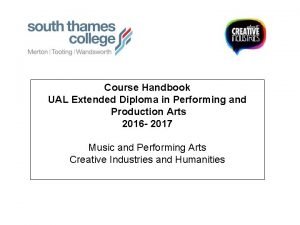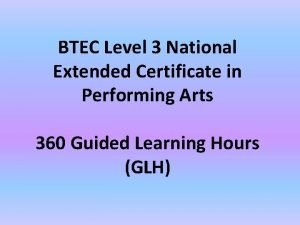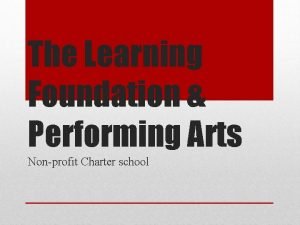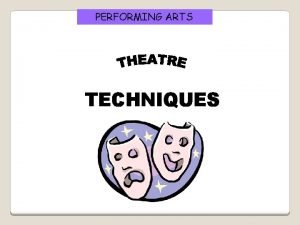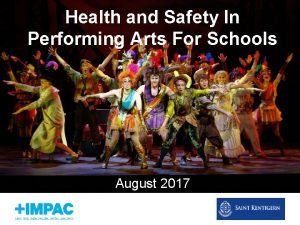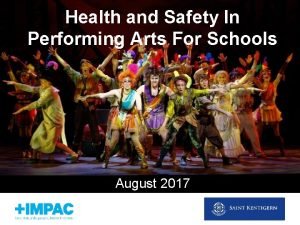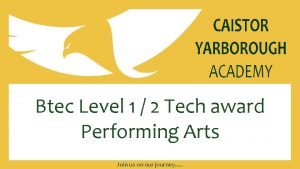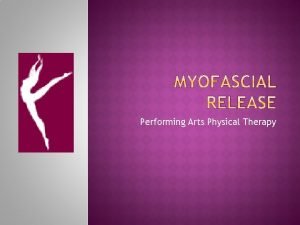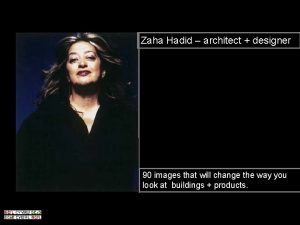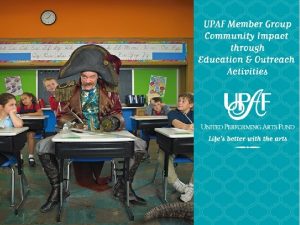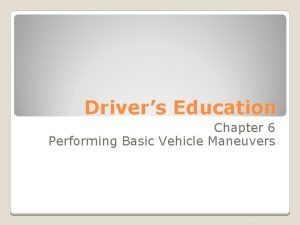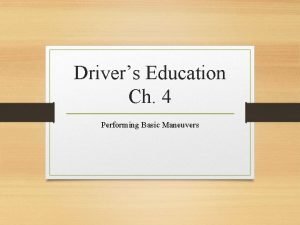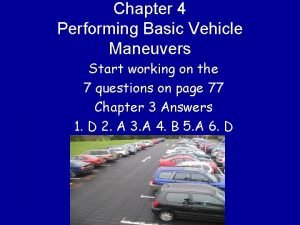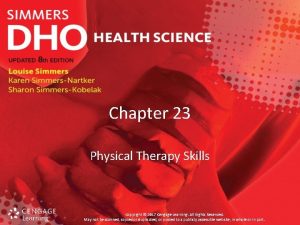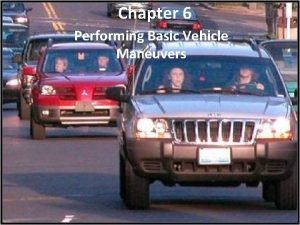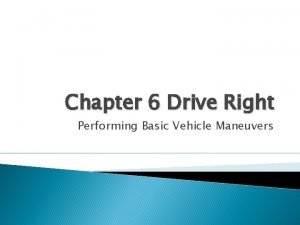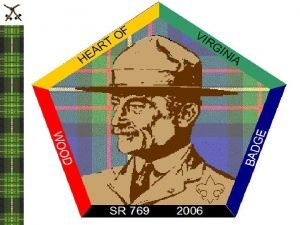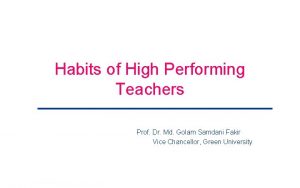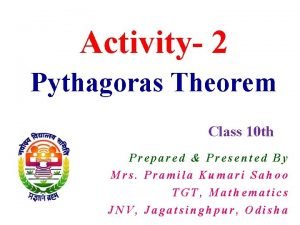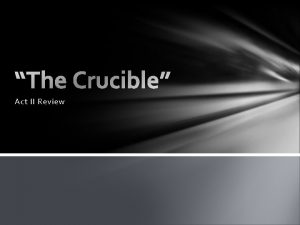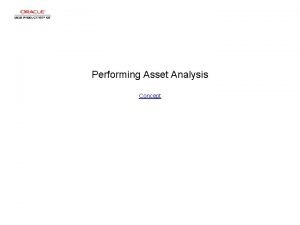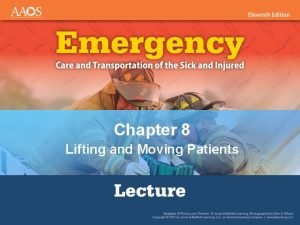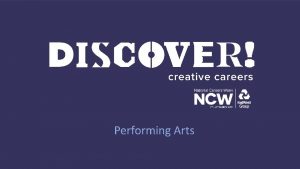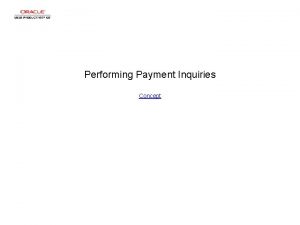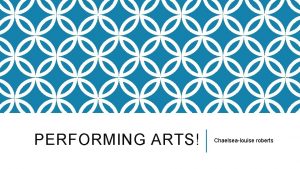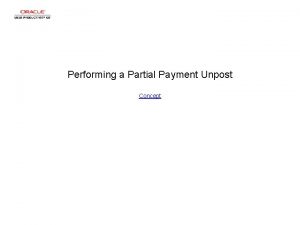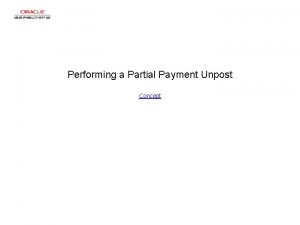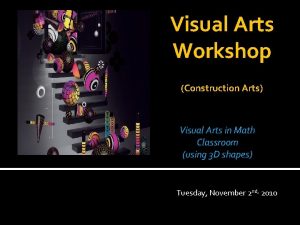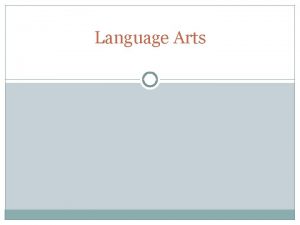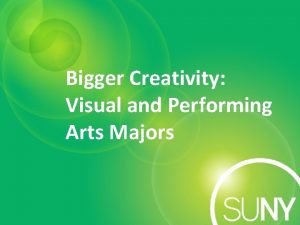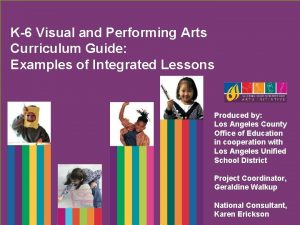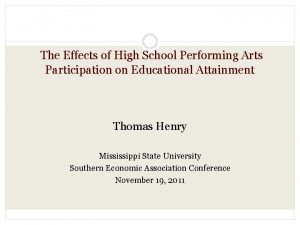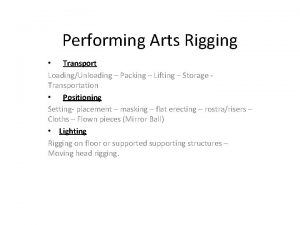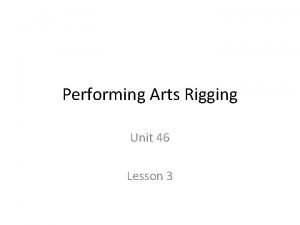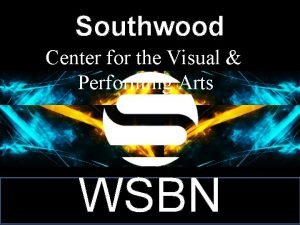Chapter 6 Performing Arts Performing Arts Performing arts





























- Slides: 29

Chapter 6: Performing Arts

Performing Arts • Performing arts are a form of art in which artists use their voices or bodies, often in relation to other objects, to convey artistic expression. • Performing arts can help explain our emotions, expressions, and feelings. • It is different from visual arts, which is when artists use paint, canvas or various materials to create physical or static art objects. • Performing arts include several disciplines, each performed in front of a live audience. • Live performances before an audience are a form of entertainment.

Performers • Artists who participate in performing arts in front of an audience are called performers. Examples of these include actors, comedians, dancers, magicians, circus artists, musicians, and singers. • Performing arts are also supported by workers in related fields, such as songwriting, choreography, and stagecraft. • Performers often adapt their appearance, such as with costumes and stage makeup, stage lighting, and sound. • Theatre, music, dance, and other types of performances are present in all human cultures.

Theater • Theater is the branch of performing arts that is concerned with acting out stories in front of an audience, using a combination of speech, gesture, music, dance, sound, and spectacle. • Theatre takes such forms as plays, musicals, opera, ballet, illusion, mime, improvisational theatre, comedy, magic, pantomime, etc. • Theater is a collaborative form of fine art that uses live performers, typically actors or actresses, to present the experience of a real or imagined event before a live audience in a specific place, often a stage. The performers may communicate this experience to the audience through combinations of gesture, speech, song, music, and dance.

Children’s Theatre • Children's theater is formal children’s performances. • It includes organizations that are dedicated to children and theater. • Children’s theater focuses on performing arts types such as plays, puppet shows, etc. , that are intended for a young audience. • Children’s theater also includes the audiences and buildings that are dedicated to children's theater.

Dance • In the context of performing arts, dance generally refers to human movement, typically rhythmic and to music, used as a form of audience entertainment in a performance setting. • Definitions of what constitutes dance are dependent on social, cultural, aesthetic artistic and moral constraints, and range from functional movement (such as folk dance) to codified, virtuoso techniques such as ballet.

Dance continued… • Dance is a powerful impulse, but the art of dance is that impulse channeled by skillful performers into something that becomes intensely expressive and that may delight spectators who feel no wish to dance themselves. • These two concepts of the art of dance-dance as a powerful impulse and dance as a skillfully choreographed art (choreography is the art of making dances, and the person who practices this art is called a choreographer) practiced largely by a professional few-are the two most important connecting ideas running through any consideration of the subject.

Music • Music is an art form which combines pitch, rhythm, and dynamic in order to create sound. • It can be performed using a variety of instruments and styles and is divided into genres such as classical music, art music, music for religious ceremonies, folk, jazz, hip hop, pop, and rock, etc. • As an art form, music can occur in live or recorded formats, and can be planned or improvised. • As music is a protean art, it easily coordinates with words for songs as physical movements do in dance.

Acrobatics • Acrobatics is the performance of extraordinary human feats of balance, agility, and motor coordination. • It can be found in many of the performing arts, sports (sporting) events, and martial arts. • Acrobatics is most often associated with activities that make extensive use of gymnastic elements, such as acro dance, circus, and gymnastics, but many other athletic activitiessuch as ballet and diving-may also employ acrobatics.

Ballet • Ballet is a type of performance dance that originated during the Italian Renaissance in the 15 th century and later developed into a concert dance form in France and Russia. • It has since become a widespread, highly technical form of dance with its own vocabulary based on French terminology. • It has been globally influential and has defined the foundational techniques used in many other dance genres and cultures.

Ballet Vocabulary • Allegro. Brisk, lively motion. An attribute of many movements, including those in which a dancer is airborne (e. g. , assemblé, changement, entrechat, sauté, sissonne, soubresaut). • Attitude. A position in which a dancer stands on one leg (the supporting leg) while the other leg (working leg) is raised and turned out with knee bent to form an angle of approximately 90° between the thigh and the lower leg. • Balancé. A rocking sequence of three steps-fondu, relevé, fondu (down, up, down)-executed in three counts.

Circus & Clown • A circus is a company of performers who put on diverse entertainment shows that include clowns, acrobats, trained animals, trapeze acts, musicians, dancers, hoopers, tightrope walkers, jugglers, magicians, unicyclists, as well as other object manipulation and stuntoriented artists. • Circus skills are performed as entertainment in circus, sideshow, busking, or variety, vaudeville or music hall shows.

Clown Terms • Gags, Bits and Business-the individual motions the clown uses, often used to express the clown's character. Gag-very short piece of clown comedy that, when repeated within a "bit" or "routine, " may become a running gag. • Menu. Entrée-clowning acts lasting 5 -10 minutes. Typically made up of various gags and bits, usually within a clowning framework. • Interludes. "Clown Stops" or "interludes" are the brief appearances of clowns in a circus while the props and rigging are changed. These are typically made up of a few gags or several bits. • Prop stunts. Among the more well-known clown stunts are: squirting flower; the "toomany-clowns-coming-out-of-a-tiny-car" stunt; doing just about anything with a rubber chicken, tripping over one's own feet or riding any number of ridiculous vehicles or "clown bikes. ”

Magic, along with its subgenres of, and sometimes referred to as illusion, stage magic or street magic is a performing art in which audiences are entertained by staged tricks or illusions of seemingly impossible feats using natural means.

Magic Terms • Production: The magician produces something from nothing-a rabbit from an empty hat, a fan of cards from thin air, a shower of coins from an empty bucket, a dove from a pan, or the magician himself or herself, appearing in a puff of smoke on an empty stage-all of these effects are productions. • Vanish: The magician makes something disappear-a coin, a cage of doves, milk from a newspaper, an assistant from a cabinet, or even the Statue of Liberty. • Transformation: The magician transforms something from one state into another-a silk handkerchief changes color, a lady turns into a tiger, an indifferent card changes to the spectator's chosen card.

Magic Terms continued… • Restoration: The magician destroys an object-a rope is cut, a newspaper is torn, a woman is cut in half, a borrowed watch is smashed to pieces-then restores it to its original state. • Transposition: This is whereby two or more objects are used in play. • Transportation: The magician causes something to move from one place to another-a borrowed ring is found inside a ball of wool, a canary inside a light bulb, an assistant from a cabinet to the back of theatre, or a coin from one hand to the other. When two objects exchange places, it is called a transposition: a simultaneous, double transportation. • Escape: The magician (or less often, an assistant) is placed in a restraining device (i. e. , handcuffs or a straitjacket) or a death trap, and escapes to safety. Examples include being put in a straitjacket and into an overflowing tank of water and being tied up and placed in a car being sent through a car crusher.

Mime Show • A mime or mime artist is a person who uses mime as a theatrical medium or as a performance art. • Miming involves acting out a story through body motions, without use of speech. • In earlier times, in English, such a performer would typically be referred to as a mummer. • Miming is distinguished from silent comedy, in which the artist is a seamless character in a film or sketch.

Opera • Opera is a form of theatre in which music has a leading role and the parts are taken by singers. • Such a 'work' (the literal translation of 'opera') is typically a collaboration between a composer and a librettist and incorporates a number of the performing arts, such as acting, scenery, costumes and sometimes dance or ballet.

Puppetry • Puppetry is a form of theatre or performance that involves the manipulation of puppetsinanimate objects, often resembling some type of human or animal figure, that are animated or manipulated by a human called a puppeteer. • Such a performance is also known as a puppet play/puppet show. • The puppeteer uses movements of her hands, arms, or control devices such as rods or strings to move the body, head, limbs, and in some cases the mouth and eyes of the puppet.

Speech • Speech (also called oratory or oration) is the process or act of performing a talk to a live audience. • Public speech is deliberately structured with three general purposes: to inform, to persuade and to entertain. • Speech is commonly understood as formal, face-to-face speaking of a single person to a group of listeners.

Ventriloquism • Ventriloquism, or ventriloquy, is an act of stagecraft in which a person (a ventriloquist) changes his or her voice so that it appears that the voice is coming from elsewhere, usually a puppeteered "dummy. " • The act of ventriloquism is ventriloquizing, and the ability to do so is commonly called in English the ability to "throw" one's voice. • One challenge ventriloquists face is that all the sounds that they make must be made with lips slightly separated. • For the labial sounds f, v, b, p, and m, the only choice is to replace them with others. • A widely parodied example of this difficulty is the "gottle o' gear", from the reputed inability of less skilled practitioners to pronounce "bottle of beer. "

Integrating Performing Arts • Integrating performing arts in the classroom have been found to be successful and accessible to learners in the learning process across all subject areas of math, social studies, science, and language arts. • Performing arts integrated in content areas promotes creativity in problem solving, creative expression, social skills, and learner development. • Academically, performing arts integration improves students’ learning. • For example, students’ performance has improved with theater arts integrated in their studies in math and other subject areas. • Students showed deeper learning and longer retention of knowledge as well. Performing arts integrated learning is active and multi-sensory.

Integrating Performing Arts continued … In elementary classrooms, performing arts could be implemented creatively through a variety of activities. Gidcumb suggested five ideas of activities for any classroom to get started: 1. Actor’s Toolbox; 2. Tableau; 3. Tapping In; 4. Stepping Into the Painting; and 5. Biography Drama. Activities based on performing arts such as drama are fun to learn and conducive to knowledge retention and learner development.

Integrating Performing Arts: Social Studies • In Social Studies, the curriculum lends itself for performing arts integration. • Performing arts allow for multiple views of culture and historical events. • Using performing arts in the learning process also provides students a multisensory approach to learning social studies content. • Performing arts such as dance provides an alternative way of communication and relate to students’ daily life as well. • In social studies, culture is the core of the subject. • Performance allows of the multicultural aspects of culture to come to live through performing arts activities.

Integrating Performing Arts: Social Studies continued … • Other performing arts forms such as Ballet could be used in the classroom to learn social content as well. • Burstein and Knotts (2011) gave the example of Westward Expansion with Ballet integrated. • In the example, dance and movement could be used to enact the Westward Expansion; students can create dance movements to show the common daily activities of cowboys, families in wagon trains, and Native Americans; they can compile all the pieces into a ballet to demonstrate the events of people moving West in the 1800's.

Video 1 Education Through Drama and Theater https: //www. youtube. com/watch? v=v. OLhl. Qh. FFKo

Video 2 Arts Integration: The Elements of Dance https: //www. teachingchannel. org/videos/integrating-dance-into-lessons

Technology: https: //itunes. apple. com/us/app/ballet-for-beginners/id 381073635? mt=8

Activity: Dance/Performing Arts Lesson Plans http: //www. teach-nology. com/teachers/lesson_plans/arts/dance/
 Ual harvard referencing
Ual harvard referencing Unit 3 group performance workshop
Unit 3 group performance workshop Learning foundation and performing arts
Learning foundation and performing arts Performing arts techniques
Performing arts techniques Health and safety in performing arts
Health and safety in performing arts Health and safety in performing arts
Health and safety in performing arts Btec tech award performing arts
Btec tech award performing arts Performing arts physical therapy
Performing arts physical therapy Zaha hadid abu dhabi performing arts centre
Zaha hadid abu dhabi performing arts centre United performing arts company
United performing arts company Grade 5 creative arts term 3
Grade 5 creative arts term 3 Chapter 6 drivers ed test
Chapter 6 drivers ed test Basic maneuvers driving
Basic maneuvers driving Performing basic maneuvers chapter 4
Performing basic maneuvers chapter 4 Chapter 23:1 performing range of motion
Chapter 23:1 performing range of motion Chapter 17:2 performing cardiopulmonary resuscitation
Chapter 17:2 performing cardiopulmonary resuscitation Angle parking begins with your vehicle *
Angle parking begins with your vehicle * Driving maneuvers diagrams
Driving maneuvers diagrams Forming-storming-norming-performing
Forming-storming-norming-performing Daniel gerson oecd
Daniel gerson oecd Voice communication army
Voice communication army High performing teachers
High performing teachers Hadoop io
Hadoop io Activity 20 to verify pythagoras theorem
Activity 20 to verify pythagoras theorem What duty has mary warren been performing in salem
What duty has mary warren been performing in salem Performance task description
Performance task description Performing asset meaning
Performing asset meaning Performing financial analysis
Performing financial analysis Rapid extrication technique emt
Rapid extrication technique emt Onychophagy nail disorder
Onychophagy nail disorder
